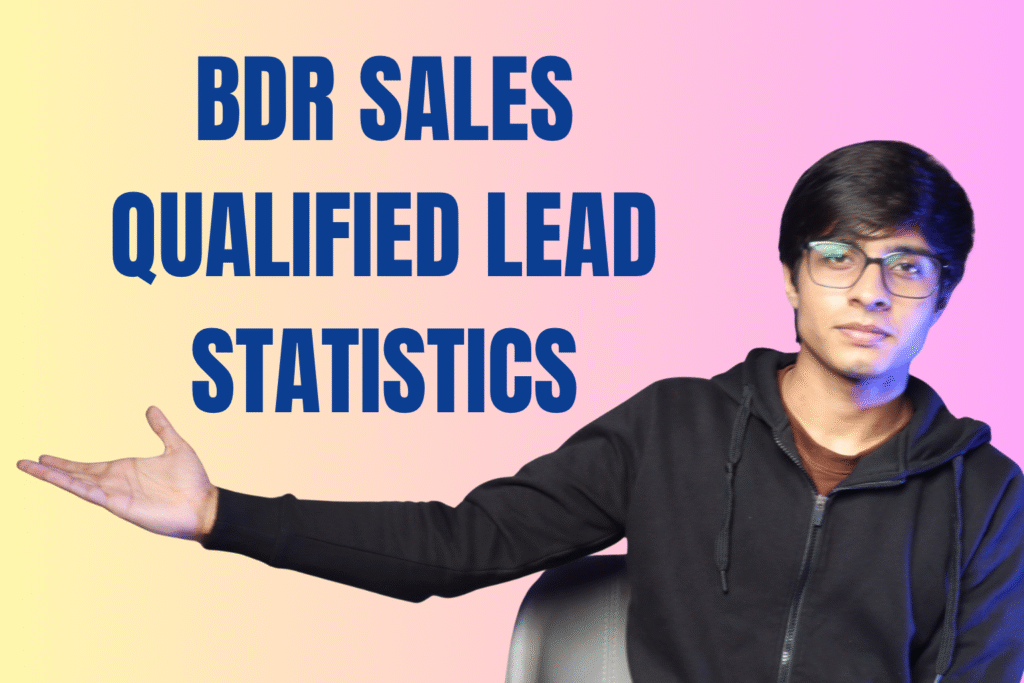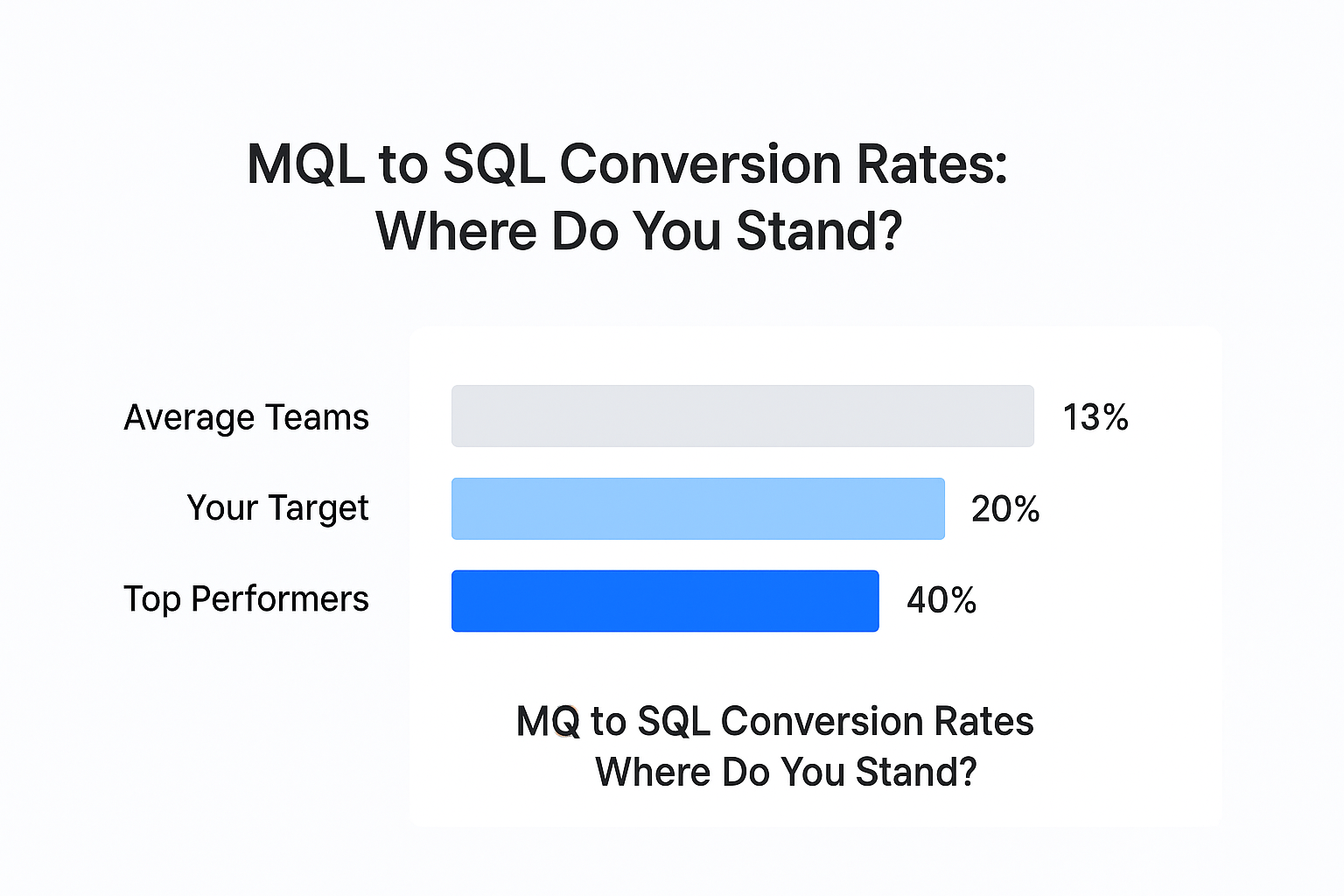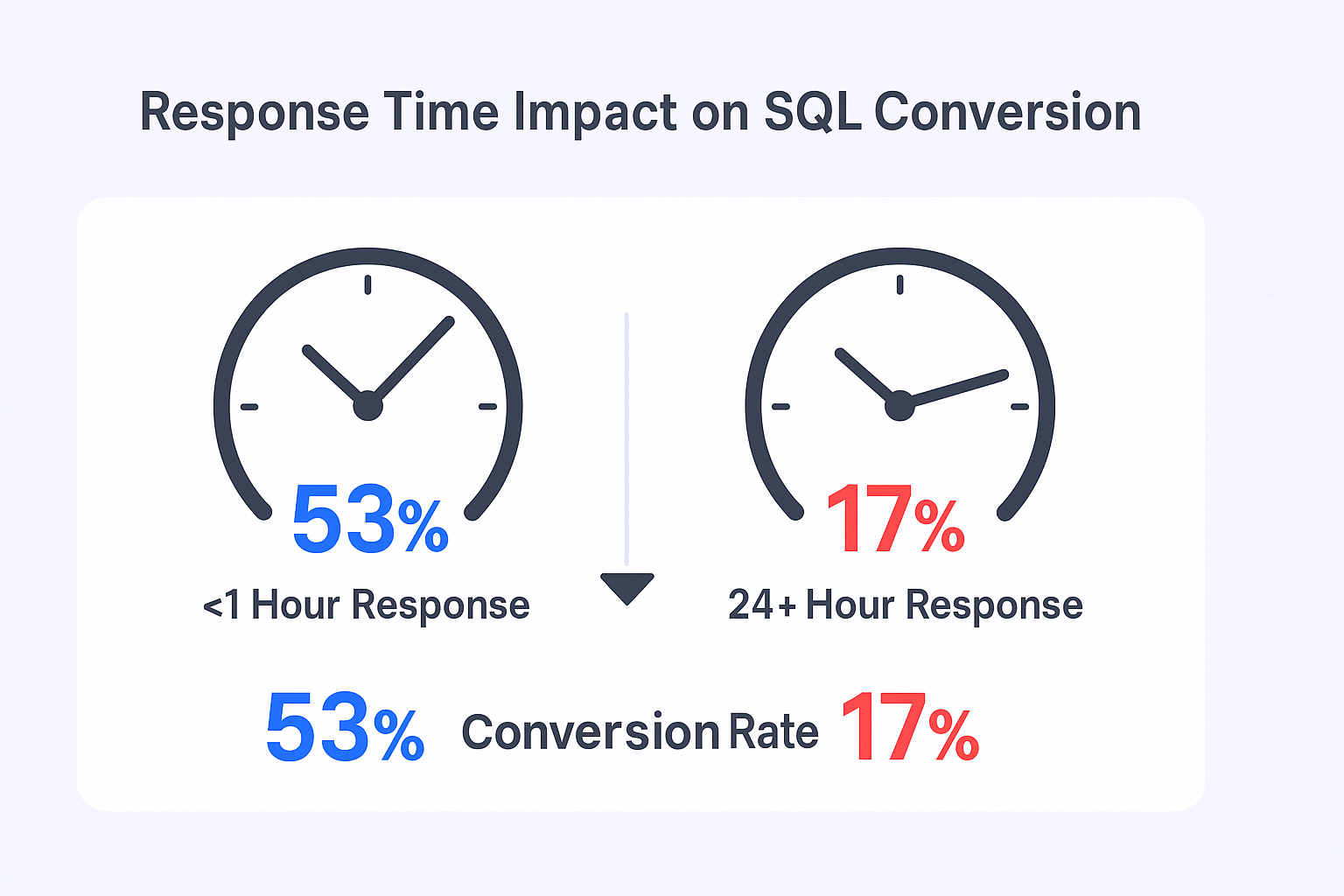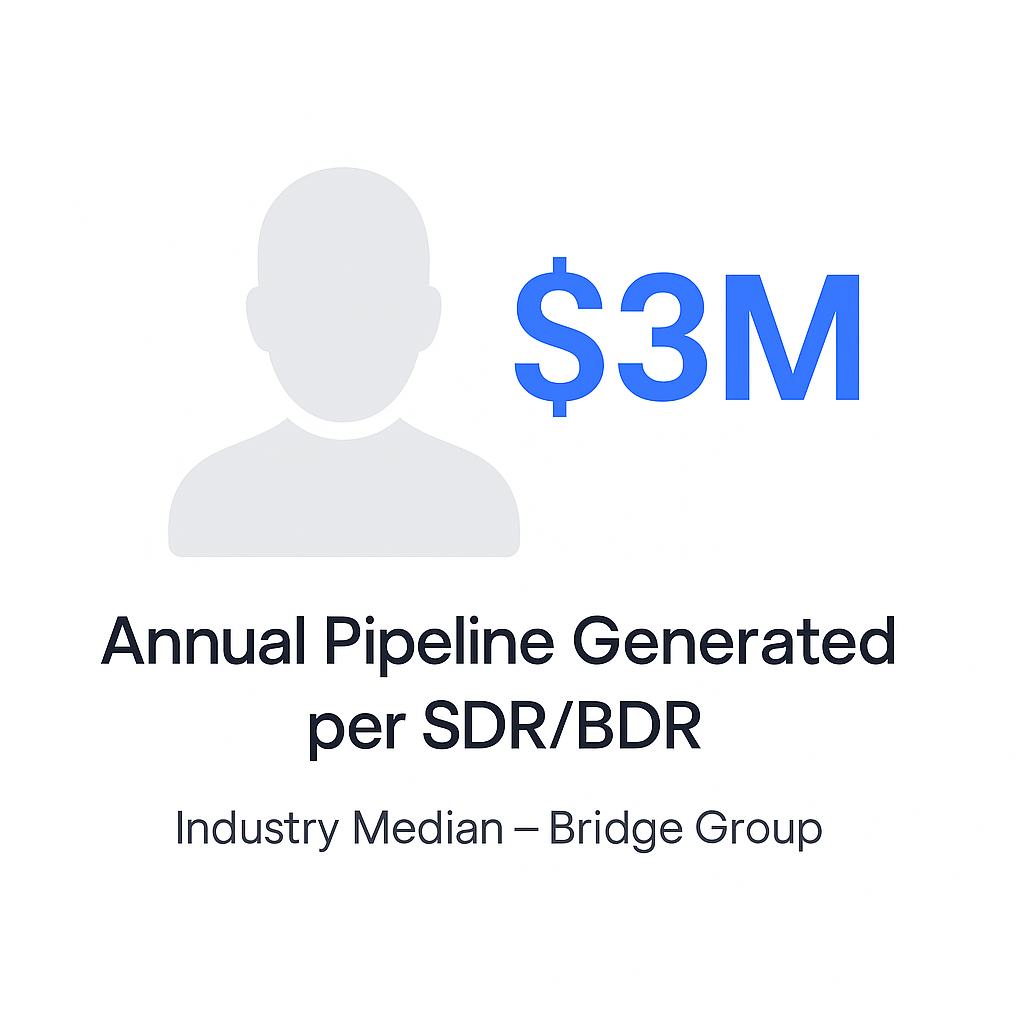- blog
- Statistics
- BDR Sales Qualified Lead Statistics: 2025 Data & Insights

BDR Sales Qualified Lead Statistics: The 2025 Data You Actually Need
Table of Contents
BDR Sales Qualified Lead Statistics
- Average MQL to SQL conversion rate sits at just 13%, meaning only 13 out of 100 marketing qualified leads become sales qualified
- Top-performing B2B SaaS companies achieve conversion rates as high as 40%—more than three times the average
- Teams contacting SQLs within the first hour see a 53% conversion rate, dropping to just 17% after 24 hours
- Only 13% of B2B leads eventually turn into opportunities, with the journey taking an average of 84 days
- Median pipeline generated per sales development rep is $3 million per year in pipeline value, not closed revenue
- Companies with dedicated BDR teams see a 25% increase in sales-qualified leads compared to those without structured development
- Teams with dedicated qualification roles also see a 15% increase in closed deals by focusing AE time on selling
- 54% of leads generated by marketing are deemed poorly qualified or underqualified by sales teams, showing major disconnect
- Average SAL to SQL conversion rate is 52.7%, meaning about 1 in 2 sales accepted leads progress to the next stage
- 82% of buyers are willing to accept meetings when sellers initiate contact through cold outreach when done properly
- 60% of business development reps fail to meet their targets, with the issue being efficiency and process, not effort
- Teams using AI for lead qualification report a 50% increase in conversion rates compared to manual qualification
- Businesses using automation for lead qualification reduce their lead processing time by 60% through efficiency
- 80% of B2B sales interactions are expected to be AI-powered by 2025, showing rapid technology adoption
- Development reps average just 4.4 quality conversations per day, which has dropped 45% since 2014 due to lower contact rates
Let’s be honest—generating sales qualified leads in 2025 feels harder than ever. You’re dealing with longer buying cycles, smarter buyers, and a mountain of tools promising to fix everything. But here’s the thing: the data tells a very different story than what most people think.
The real issue isn’t that generating SQLs is impossible. It’s that most teams are using outdated playbooks while the top performers are crushing it with a completely different approach. The gap between average and excellent SQL generation has never been wider, and the numbers prove it.
In this guide, we’re breaking down the most important BDR sales qualified lead statistics for 2025. These aren’t vanity metrics—they’re the real numbers that separate teams hitting quota from those constantly scrambling. Whether you’re trying to understand your current performance or build a case for better tools and processes, this data will give you exactly what you need.

Key BDR Sales Qualified Lead Statistics
SQL Conversion Performance: The Reality Check
Here’s where most sales teams get their wake-up call. The average MQL to SQL conversion rate sits at just 13%. That means for every 100 marketing qualified leads your team receives, only 13 turn into actual sales qualified leads that your closers want to touch.
But here’s where it gets interesting. Top-performing B2B SaaS companies are achieving conversion rates as high as 40%—more than three times the average. What’s their secret? Better lead qualification frameworks, faster response times, and smarter use of technology.
Speaking of response times, this stat should change how you think about lead follow-up: teams that contact SQLs within the first hour see a 53% conversion rate. Wait 24 hours? That drops to just 17%. Speed isn’t just nice to have—it’s everything.

📊 Double Your SQL Conversion Rate
LinkedIn outbound targets decision-makers directly—no waiting for inbound MQLs to convert
The pipeline reality is even tougher. According to Salesforce, only 13% of B2B leads eventually turn into opportunities, and the average journey from lead to opportunity takes a painful 84 days. That’s nearly three months of nurturing, following up, and praying nothing falls through the cracks.
Pipeline Generation Impact: What Good Teams Actually Produce
Let’s talk real numbers. The median pipeline generated per sales development rep is $3 million per year, according to the Bridge Group’s research. That’s not revenue—that’s pipeline value. But it shows you what a well-functioning rep can contribute to your bottom line.

Companies that invest in dedicated business development teams see measurable results. Research shows these teams drive a 25% increase in sales-qualified leads compared to companies relying solely on marketing or account executives to handle qualification. Another study found a 20% increase in SQLs when companies implement structured processes for their development teams.
The impact doesn’t stop at lead generation. Teams with dedicated roles focused on qualification also see a 15% increase in closed deals. Why? Because account executives spend more time selling to qualified prospects instead of chasing bad fits or doing discovery work.
Text #2
🎯 Generate $5M+ Pipeline Annually
Our LinkedIn campaigns deliver pre-qualified SQLs through precision targeting and automated personalization at scale
Lead Qualification Efficiency: The Hidden Bottleneck
Here’s a stat that might sting a bit: 54% of leads generated by marketing are deemed poorly qualified or underqualified by sales teams. That’s more than half. This disconnect between sales and marketing isn’t just annoying—it’s costing you real pipeline.
But when the handoff works properly, the numbers improve dramatically. The average SAL to SQL conversion rate is 52.7%, meaning about 1 in 2 sales accepted leads progress to the next stage. If your team is converting significantly below this, you’ve got a qualification problem, not a lead volume problem.
There’s good news buried in the data, though. Research shows that 82% of buyers are willing to accept meetings when sellers initiate contact through cold outreach. The problem isn’t that people won’t take meetings—it’s that most outreach is poorly timed, badly personalized, or just not relevant.
Unfortunately, the reality for most reps is tough. According to combined research from the Bridge Group and HubSpot, 60% of business development reps fail to meet their targets. The issue isn’t usually effort—it’s efficiency and process.
AI BDR & Automation Impact: The Game Changer
This is where things get really interesting. Teams using AI for lead qualification report a 50% increase in conversion rates. Not 5%. Not 15%. Fifty percent. That’s the kind of improvement that turns struggling teams into top performers.
The time savings are equally dramatic. Businesses using automation for lead qualification reduce their lead processing time by 60%. Instead of spending hours manually researching and scoring leads, AI handles the heavy lifting while your team focuses on actual conversations.
Real-world results back this up. One SaaS company using AI-powered lead qualification tools saw a 70% increase in sales-qualified leads within just three months. Another organization using predictive analytics quadrupled their conversion rate from 4% to 18%.
Looking ahead, the trend is clear: 80% of B2B sales interactions are expected to be AI-powered by 2025. Companies implementing these tools early are seeing a 30% increase in conversion rates for AI-powered qualification systems compared to manual processes.
🚀 AI-Powered LinkedIn Outbound Engine
We combine AI targeting with human-crafted messaging to book 15-25 qualified meetings monthly
Activity & Productivity Metrics: The Daily Grind
Let’s get into the weeds of what daily activity actually looks like. Outbound-focused reps produce an average of 15 meetings per month, with about an 80% show rate. That means roughly 12 held meetings per month—or about 3 per week.
Here’s a concerning trend: development reps average just 4.4 quality conversations per day. Even worse, this number has dropped by 45% since 2014. The culprit? Lower contact rates, worse data quality, and buyers becoming increasingly hard to reach.
The persistence required is real. It takes an average of 18 or more dials just to connect with a single prospect. And the typical sales organization runs at a ratio of 2.6 account executives for every 1 sales development rep.
Multi-Channel & Follow-Up Statistics: The Persistence Playbook
Here’s where most teams quit too early. Research shows that 80% of sales require at least five follow-up attempts before converting. Yet many reps give up after just one or two touches.
The data on personalization is equally clear. 77% of buyers say they’re more likely to consider a brand that offers personalized experiences. Generic, spray-and-pray outreach doesn’t just underperform—it actively damages your brand.
There’s a fascinating psychological element at play too. Studies show that 60% of customers say “no” four times before eventually saying “yes”. The top performers understand this and build their cadences accordingly. They’re not being pushy—they’re being persistent with value.
Multi-channel approaches significantly improve results. Companies using coordinated email, phone, and social outreach see better conversion rates and lower cost-per-lead compared to single-channel strategies.
💼 LinkedIn + Email = 4x Response
Our multi-channel outbound system coordinates LinkedIn and email touches for maximum SQL conversion rates
7-day Free Trial |No Credit Card Needed.
Conclusion
The data paints a clear picture: generating quality sales qualified leads in 2025 isn’t about working harder—it’s about working smarter. The gap between average performers (13% MQL to SQL conversion) and top performers (40% conversion) comes down to three things: speed, qualification frameworks, and technology.
The teams crushing it right now aren’t manually scoring every lead or waiting days to follow up. They’re using AI-powered tools to qualify faster, responding within an hour to hot leads, and building multi-channel cadences that actually convert.
Here’s your takeaway: focus on velocity and quality over volume. A smaller list of well-qualified leads that you contact quickly will outperform a massive database of mediocre prospects every single time. Invest in lead scoring systems, automate the repetitive work, and free your team to focus on genuine conversations.
And if you’re serious about maximizing your outreach efficiency, tools like Salesso can help you scale your email prospecting while maintaining the personalization that buyers actually respond to. Because at the end of the day, the right message to the right person at the right time—that’s what turns marketing qualified leads into pipeline.
FAQs
What is a good MQL to SQL conversion rate?
How many SQLs should a sales development team generate per month?
What's the biggest challenge in generating sales qualified leads?
How does AI improve SQL generation?
What's the ideal follow-up cadence for converting MQLs to SQLs?

Transform SQLs with LinkedIn Outreach
Our proven outbound engine generates 3x more qualified meetings than cold calling alone
Segmentation That Actually Converts
LinkedIn outbound targets precise demographics with strategic campaign design and scaling methods

